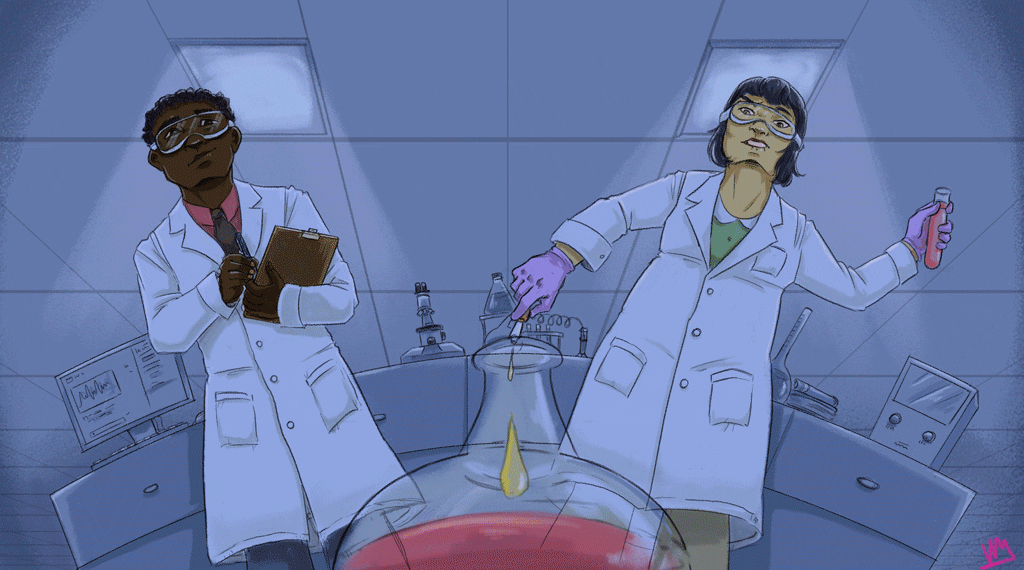Science is supposed to be forward-looking, apolitical, gender-neutral, colour-blind, open to all and only focused on revealing the truth. But when it comes to sexual orientation and gender identity, science can still be as old-fashioned, straight and cisgender as President Donald Trump’s cabinet.
Science has always been a bit slow on the uptake when it comes to LGBT issues. For example, it wasn’t until 1987 that homosexuality was completely removed from the Diagnostic and Statistical Manual of Mental Disorders (DSM) as a treatable condition.
So while society seems to be making great leaps towards a more accepting, inclusive and open culture for some LGBT individuals, science feels stuck in an outdated mentality.
For Anthony Bonato, a professor of mathematics at Ryerson University, this became glaringly apparent when he found himself looking for a role model.
“Within mathematics there were no gay, lesbian, transgender mathematicians that I really knew personally, or more broadly in the community, who I could really fashion myself [after] or be a role model for me,” he says in a telephone interview.
Bonato has been a mathematician for 20 years and has found navigating the academic workplace as a gay man to be challenging. He has never outright hid his sexuality but rather compartmentalized it and didn’t speak about it with his colleagues.
“I always felt a little awkward,” he says. “Should I bring it up? If I’m at a conference and I’m with colleagues and their spouses and their family and their children, can I talk about my husband? Can I be queer?”
In his blog he also details some of the more blatant discrimination he’s endured, such as when one of his colleagues said he was “uncomfortable” with Bonato’s “gayness.”
Today Bonato is an openly gay and proud mathematician, thanks to the supportive and inclusive environment that he says Ryerson University offers, but he notes that his candour is far from the norm.
Trapped in the closet
A US survey conducted in 2013 found more than 40 percent of queer science, technology, engineering, and math (STEM) workers had not told their colleagues, coworkers or students about their identities.
Unfortunately, not much has changed according to the 2016 follow-up survey, which was presented last February at the American Association for the Advancement of Science conference.
However, levels of openness can vary, notes Jeremy Yoder, an assistant professor of biology at California State University in Northridge.
Yoder, who worked on both surveys, says different disciplines see varying degrees of openly LGBT scientists but cisgender queer people, and those who work in fields with more women, are overall more likely to be out at work.
Vicky Forster, who has worked in the UK and now in Canada as a children’s cancer researcher, says she’s never had an issue being open about her sexuality.
“Here in Toronto and where I was in the UK I’ve never had any hesitation,” she says. “My colleagues know I’m LGBT and have a same-sex partner.”
She believes her confidence to be open about her sexuality may be in part because her field is more gender balanced than most other science, tech, engineering and math fields.
As it stands now, more than half of all female scientists are in life sciences, psychology and social sciences, according to National Science Foundation’s latest report.
Forster thinks this is due to attitudes, which are still upheld in many parts of the world, around gendering science fields. “Biology, encompassing plants, animals and flowers, for example, is often pushed in schools and by parents as a more ‘girly’ choice, whereas physics and engineering featuring space, astronauts and machines is considered to be more for boys,” she says.
In comparison, physics has less than 20 percent women and a survey conducted by the American Physics Society found that 30 percent of LGBT physicists felt the need to remain closeted at work. About one in five reported suffering isolating or exclusionary behaviour by their peers.
The survey also found the heaviest brunt was experienced by trans or gender non-conforming members.
University of Toronto physics professor AW Peet, who identifies as non-binary, trans and bisexual, says this lack of female presence has created a less than accepting environment.
“Physics is just generally less hospitable to feminine people and to interrogating the question to how gender is relevant,” they say in a phone interview.
Peet is out on campus but the experience has been challenging and not all pleasant. They’ve faced inappropriate personal questions and harassment and had to fight hard to get an all-gender bathroom on their floor. Peet says the university was supportive in addressing the harassment but wonders if that support may have waned for a less well-regarded member of faculty.
Unlike Peet, many LGBT scientists choose to stay closeted, in part, Yoder and Bonato say, due to the taboo in the science industry against letting your personal life filter into your work life.
“The stereotype is of this scientist or mathematician being purely objective, almost a robotic computer,” Bonato says.
According to Yoder, scientists may choose to remain closeted because there’s a perception that individual identity factors, such as sexuality or gender identity, are irrelevant to scientific professional achievement. In other words, you don’t bring your personal life into the lab.
Hurting research
No matter what the reason, remaining in the closet is negatively impacting research in more ways than one.
“Purely from the emotional and energy toll it takes to hide a fundamental part of your identity in research settings, it’s exhausting to have a baseline level of anxiety associated with being vigilant that way,” explains Sarah Dungan, a PhD candidate in the department of ecology and evolutionary biology at the University of Toronto.
Doing graduate work in science, tech, engineering and math is “already very taxing and has its own host of mental health stressors,” she says. “Adding layers of marginalization onto that is the reason we still have so many representation problems in STEM fields.”
In recent years there has been a push from government and academic institutions towards more diversity in these fields. But most of the initiatives have largely focused on women and racial minorities rather than explicitly encouraging queer people to sign up.
“There is not very much queer awareness,” Bonato says, citing a lack of diversity on panels, editorial boards, granting agencies and hiring committees. “I wish there was even a very concerted effort to increase things like research chairs or scholarships aimed at LGBT students or faculty.”
And evidence shows that diversity can lead to better science. A 2014 article in Scientific American notes that “simply interacting with individuals who are different forces group members to prepare better, to anticipate alternative viewpoints and to expect that reaching consensus will take effort.”
“Having a diversity of people working in science, using what we hope are objective and replicable methods and understanding that they’re coming with a lot of different perspectives is good because the more different angles you attack a problem, the more likely you are to solve them,” Yoder says.
“STEM flourishes in an environment where people are nurtured,” Bonato says. “Cures for diseases, and progress in physics and all the rest will be so much richer and more powerful when all groups have the opportunity to contribute equally.”
Having more visible queer scientists is also beneficial to the younger generation of scientists.
“I’m sure that there’s a transgender teenage girl somewhere that has the proof of the Riemann hypothesis sitting in her brain and I’m really concerned about her, about whether she’s being bullied or assaulted or discriminated against,” Bonato says.
It’s difficult to get kids interested in science or math if they’re worried about getting beaten up for who they are, he notes.
Bonato stresses the importance of mentorship and LGBT role models in the science fields.
Peet agrees. “If you’re a young LGBT person in physics and there aren’t many out role models that you can look up to, even if you don’t plan to be much like them, just the fact of knowing that they exist can be enough to be encouraging to think maybe there is a place for me in the discipline,” they say.
Multiple organizations and groups devoted to LGBT people in the fields of science, tech, engineering and math have cropped up in recent years, including LGBT STEM, the National Organization of Gay and Lesbian Scientists and Technical Professionals and Out in Science, Technology, Engineering, and Mathematics.
There’s even a yearly LGBT STEM conference that encourages collaborations between departments and universities.
Alex Bond, the conference’s co-administrator, says it offers a welcoming space for people to be themselves personally and professionally. Since 2015 it’s doubled in size, with the latest one hosting around 120 people.
“Compared to a usual academic conference, everyone was more relaxed, there was much more humour and joking around,” Bond says. “It’s obviously filling some niche in the scientific community, at least [the] scientific LGBTQ community.”
July 5, 2018 marks the very first national LGBT in STEM day, but it’s been a long road to get to this level of visibility and acceptance.
“Most gay people were closeted for fear of stigmatization and social estrangement, which meant that considerable energy that could be spent on scientific creativity and productivity was spent on hiding the truth,” says Rochelle Diamond, who chairs the board of the National Organization of Gay and Lesbian Scientists and Technical Professionals.
Before LGBT groups started to emerge in the science world, she says, homophobia was common; medical students weren’t taught about LGBT health care needs, for example, and biology courses contained inaccurate information.
“Very little funded research about homosexuality existed — either due to disinterest on the part of granting agencies or due to researchers’ fears about seeking such funding,” she says.
It’s this climate that the national group’s organizers “sought to expose and address,” she adds.
The group has been around longer than most, forming in 1983 after some leaders from the grassroots LGBT movements in the 1970s met at the American Association for the Advancement of Science annual meeting in San Francisco. But despite its longevity, visibility is still an issue.
“Most people still are surprised to know we exist,” Diamond says. “For years it was difficult to breach the barriers of other scientific and engineering societies to hold receptions, educational meetings and the like, but over the past several years, doors are swinging open with invitations to organize workshops and receptions for their members.”
Even with all the progress against the “lavender ceiling,” Diamond says there’s still a lot to be done, especially with the newfound rise of intolerance that’s sweeping America.
The list is endless for what could be improved. “I could write a book,” she says, citing more mentors, support and awareness. She also wishes people would stop losing out on potential spousal benefits, like health insurance, in the sciences because they’re too scared to disclose their same-sex relationship.
“We can also make the queer community more accepting of scientific people,” Bond adds, who notes that last year’s American Out 100 list and British Pride Power List didn’t include a single scientist.
“We are still a long way from being able to assume we enjoy all of the same rights and privileges as we ought to,” Yoder says.
“But if you compare things to decades ago, we’re at a very different place in terms of employers feeling like they need to accommodate and accept and embrace people from a diversity of backgrounds.”


 Why you can trust Xtra
Why you can trust Xtra


